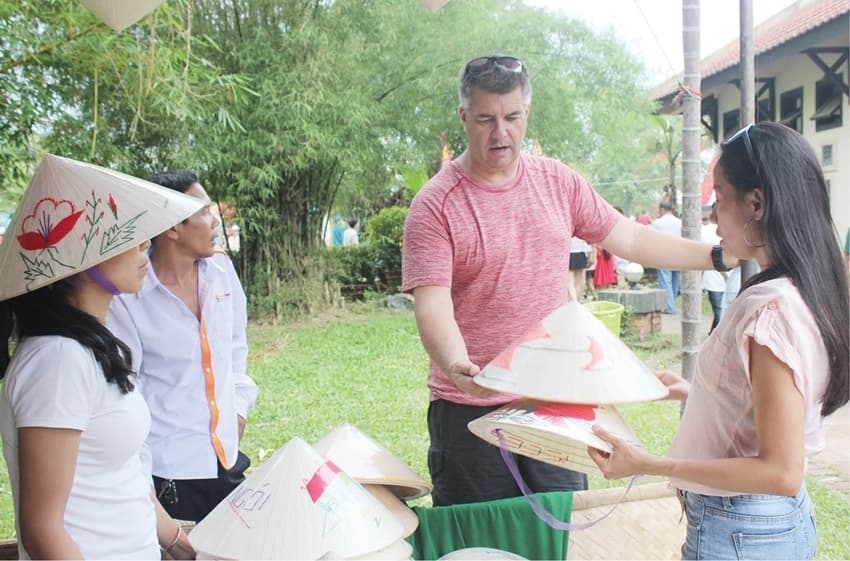Vietnam, a country steeped in rich history and vibrant culture, has long fascinated travelers with its scenic landscapes and flavorful cuisine. But beyond the popular attractions lies a lesser-explored treasure — the country’s traditional crafts, preserved through generations by skillful artisans. In recent years, more foreign tourists have been experiencing traditional Vietnamese crafts firsthand, turning their visits into immersive cultural adventures.
This article will take you on a journey across Vietnam’s craft villages and heritage workshops, where visitors not only witness age-old techniques but also become part of the creation process. From pottery in Bat Trang to lantern-making in Hoi An, these hands-on encounters offer unforgettable memories and a deeper understanding of Vietnamese heritage.

Foreign Tourists Experiencing Traditional Vietnamese Crafts: A Unique Cultural Journey
Why Are Traditional Crafts Appealing to Foreign Tourists?
Modern travelers seek more than just sightseeing; they crave authentic cultural engagement. This shift in travel behavior has given rise to experiential tourism, where people learn by doing. In Vietnam, this translates into opportunities for tourists to roll up their sleeves and try local crafts with the guidance of master artisans.
Foreign tourists experiencing traditional Vietnamese crafts find joy in:
-
Learning new skills (e.g., weaving, carving, dyeing)
-
Connecting with local artisans and understanding their way of life
-
Creating souvenirs with their own hands
-
Contributing to cultural preservation and ethical tourism
These activities go beyond entertainment—they foster empathy, cultural appreciation, and sustainability.

Why Are Traditional Crafts Appealing to Foreign Tourists?
Top Traditional Crafts in Vietnam That Tourists Can Experience
Pottery Making in Bat Trang Village
Located just 15 kilometers from Hanoi, Bat Trang Ceramic Village is one of the oldest and most famous craft villages in Vietnam. For centuries, it has produced high-quality pottery used for both daily life and ceremonial purposes.
Tourists visiting Bat Trang can:
-
Mold clay on a spinning wheel
-
Paint ceramic items using traditional glazes
-
Learn about the kiln-firing process
-
Buy handcrafted pieces as souvenirs
The tactile nature of pottery offers a deep sensory connection to Vietnamese heritage.

Pottery Making in Bat Trang Village
Lantern Crafting in Hoi An
The ancient town of Hoi An, a UNESCO World Heritage Site, is renowned for its colorful silk lanterns that illuminate its streets every evening. Making a lantern in Hoi An is both a creative and cultural experience.
Workshops often include:
-
An introduction to the history of lanterns
-
Step-by-step guidance to assemble bamboo frames
-
Choosing silk fabrics and colors
-
Crafting a functional and beautiful lantern to take home
Foreign tourists not only learn a new skill but also take part in a symbol of Hoi An’s charm.

Lantern Crafting in Hoi An
Silk Weaving in Van Phuc Village
Van Phuc Village, about 10km from Hanoi, is famous for its delicate silk products. Tourists who visit Van Phuc can:
-
Observe traditional looms in action
-
Try their hands at spinning and weaving silk
-
Learn about the natural dyeing process
-
Explore the economic and cultural role of silk in Vietnam’s past and present
Experiencing silk weaving allows visitors to witness the patience, precision, and artistry behind every meter of fabric.

Silk Weaving in Van Phuc Village
Conical Hat (Nón Lá) Making in Hue
The conical hat, or Nón Lá, is an iconic symbol of Vietnamese identity. In Hue, especially in Tay Ho village, tourists are welcome to explore the craft of hat-making.
The process includes:
-
Selecting palm leaves
-
Ironing and drying the materials
-
Assembling the bamboo frame
-
Stitching the leaves meticulously
Visitors gain an appreciation for the hat’s aesthetic and practical value and the dedication of the artisans who make them.

Conical Hat (Nón Lá) Making in Hue
Wood Carving in Dong Ky Village
Dong Ky Village in Bac Ninh Province is famous for its intricate wood carving tradition. Tourists can:
-
See how craftsmen use traditional tools
-
Try engraving on wood blocks
-
Learn about furniture design and symbolism
-
Visit family-run workshops that have operated for decades
Wood carving teaches visitors about the spiritual and decorative aspects of Vietnamese homes and temples.
Personal Stories: What Foreign Tourists Say
Anna from Germany recalls her experience in Hoi An:
“Making my own silk lantern was the highlight of my trip. It felt magical to light it up in the evening. It’s now hanging in my living room back home — a beautiful reminder of Vietnam.”
Michael from Canada, after a visit to Bat Trang, shared:
“I never thought working with clay could be so meditative. The pot I made is not perfect, but it tells a story.”
These stories demonstrate the emotional and cultural depth of engaging with traditional Vietnamese crafts.
The Educational Value of Craft Tourism
For many foreign visitors, craft workshops in Vietnam double as cultural classrooms. Participants not only acquire a new hobby but also walk away with knowledge of:
-
Vietnamese folklore and legends tied to crafts
-
Local materials (bamboo, clay, silk, etc.)
-
Rural lifestyles and community traditions
-
The effects of modernization on heritage preservation
This form of edutourism is especially appealing to families, students, artists, and anyone passionate about cultural conservation.

The Educational Value of Craft Tourism
Supporting Local Communities Through Craft Experience
Engaging in traditional crafts isn’t just fun—it’s also an act of responsible tourism. When tourists pay for workshops or buy handmade products, they directly support:
-
Local artisans and their families
-
Village economies
-
Heritage conservation efforts
In many villages, the younger generation is choosing to stay and continue the family trade, thanks to tourism. Thus, each lantern painted or piece of pottery molded by a visitor contributes to sustaining a living tradition.
Practical Tips for Tourists
To make the most of your craft experience in Vietnam:
-
Book workshops in advance, especially during tourist season
-
Choose ethical providers who pay artisans fairly
-
Respect local customs — ask before taking photos
-
Be open-minded: your craft item doesn’t have to be perfect!
Most importantly, bring your curiosity and leave with something far more valuable than a souvenir: a connection to the soul of Vietnam.
Where to Book Craft Experiences in Vietnam
Several platforms and tour operators offer craft-based excursions. Consider:
-
Vietnamese travel startups like Klook Vietnam, VietSense Travel
-
Community-based tourism programs supported by NGOs
-
Local homestays in craft villages that offer full-day or multi-day immersion
You can also check TripAdvisor or Airbnb Experiences for verified workshops and guides.
Looking to the Future: Can Craft Tourism Thrive?
As global tourism evolves post-pandemic, experiential and sustainable travel will take center stage. Vietnam, with its rich tapestry of crafts and welcoming communities, is well-positioned to lead this movement.
However, challenges remain:
-
The need for better infrastructure in rural areas
-
Language barriers in communication
-
Maintaining authenticity without commercialization
Continued support from government bodies, tourism operators, and mindful tourists will be essential in ensuring that foreign tourists experiencing traditional Vietnamese crafts remains not just a trend, but a thriving cultural exchange.
In a world where travel often means ticking off landmarks, Vietnam offers something more profound: a hands-on journey into its cultural heartbeat. By engaging with traditional Vietnamese crafts, foreign tourists don’t just watch—they participate, learn, and contribute. So next time you’re planning a trip to Vietnam, go beyond the beaches and the street food. Visit a village, meet an artisan, and create something with your hands. You’ll leave with more than just a souvenir — you’ll carry a piece of Vietnam’s soul.
